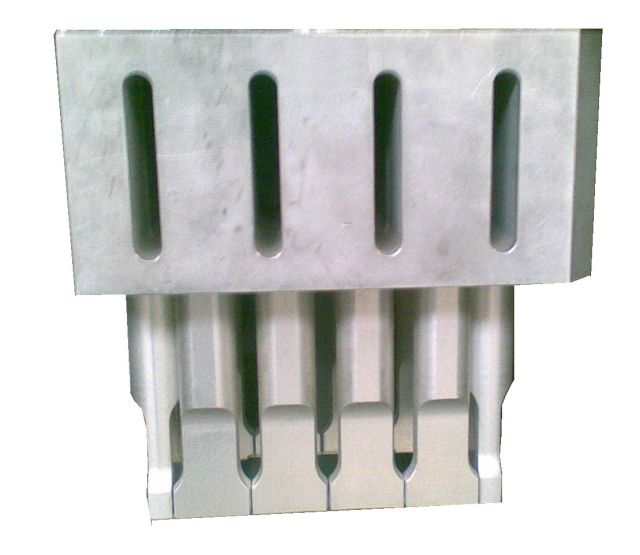This ultrasonic composite horn / sonotrode is designed in 25 kHz, with similar amplitude as 20 kHz, but the huge advantage of very little sound to be heard in welding
Email : info@sonic-power.com
The ultrasonic composite horn / sonotrode is actually a half-wave coupled horns / sonotrode with two or more half-wave, tuned horns attached to it. This technology was first used in 1973. Because designs can often eliminate the need to invest in additional ultrasonic systems, they reduce equipment investment costs and minimize production time.
Composite ultrasonic horn / sonotrode designs are common on applications that cover a large surface area and on applications where there are multiple insertion, staking, or welding points. Some of automotive customers use composite ultrasonic sonotrodes / horns to attach insulator pads to door panels or similar,
Another common application that benefits from composite ultrasonic tooling is packaging (a vacuum-formed blister package). The ultrasonic composite horn / sonotrode saves manufacturers production time and costs, as it welds the package simultaneously at several different points, instead of using a multiple-head system or having an operator / machine ultrasonic weld each point separately.
Composite ultrasonic horns / sonotrodes are also in applications where it’s difficult to create enough amplitude to weld. The amplitude at the face of a composite horn is higher than what could ever be achieved by a single large horn. The amplitude is designed into each of the individual half-wave horn attachments, not the coupler, a higher amplitude is generated at the weld area; this avoids causing excessive stress to the coupler horn.
Although composite horns / sonotrodes can eliminate the need for additional assembly systems, cut production times, and lower labor costs, they are more expensive than standard horns / sonotrodes. The added cost is due to the extra titanium or aluminum and machining time the composite horns require.
Typical ultrasonic composite horns / sonotrodes have aluminum couplers and titanium half-wave attachments. In addition to the expense of titanium, all of the half-wave attachments must be tuned within 50 cycles of each other. And they must be properly mounted onto the coupler horn. This design we have here is done with only aluminum.
The most common mounting method utilizes a 1/2 unf- or 3/8 unf stud at the top of the half-wave attachment; it’s screwed into a threaded hole at the output face of the coupler. In this case we have also used tuned titanium bolt. The bolt is mounted through the coupler; then the horn attachments are bolted to the coupler. The tuned bolt method is primarily used on composite horns that have two or more block horn / sonotrode attachments.
In addition to the extra metal and machining that’s required, composite horns have more design considerations than a standard ultrasonic horn / sonotrode. We always have to make sure the horn / sonotrode we are designing is balanced. But when we deal with composite ultrasonic horns / sonotrodes, all of the ultrasonic horns / sonotrodes attachments have to be positioned evenly around the coupler, so the weight is evenly distributed. Sometimes the attachments are different lengths and different shapes, but you still have to keep the horn balanced.
But despite the added challenges in the design and manufacture of ultrasonic composite horns / sonotrodes, they have provided consistent performance and productivity for.
Sometimes a injected molded part cannot be welded without using of ultrasonic composite horn / sonotrode, therefore application can use a ultrasonic composite horn / sonotrode, the increase in productivity and the cost savings are so great that the initial added cost in tooling is more than justified.

